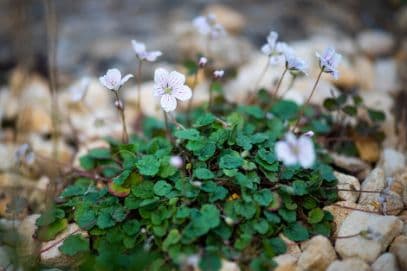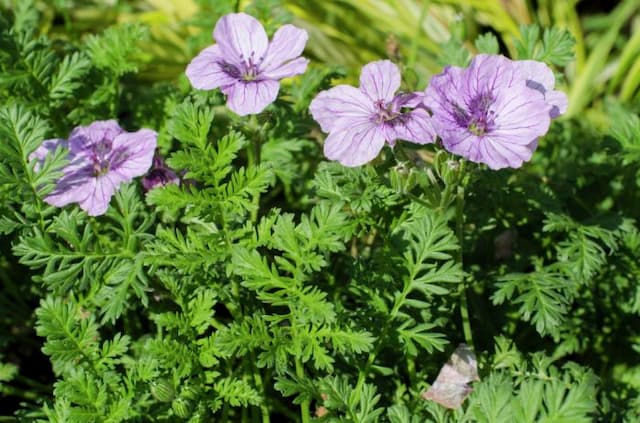Penciled Cranesbill Geranium versicolor

ABOUT
Geranium versicolor, commonly known as the Pencilled Crane's-bill, is a charming perennial plant known for its attractive foliage and flowers. This species has a bushy growth habit with rounded, lobed leaves that are softly hairy. The foliage often has an attractive marbling of darker green veins which gives this plant one of its common names. Flowers appear on long, slender stems and are notable for their distinct and intricate veining. These blossoms are usually a soft lavender or light pink color, with prominent purple lines that create a beautiful, penciled effect, hence the name "Pencilled Crane's-bill". The petals are rounded with a slight notch at the tip. This ornamental trait makes the Pencilled Crane's-bill a favorite among garden enthusiasts for its decorative value. It has a neat, mounded habit that works well in borders, rock gardens, and as ground cover.
About this plant
 Names
NamesSynonyms
Pencilled Crane's-bill, Bicoloured Geranium.
Common names
Geranium versicolor.
 Toxicity
ToxicityTo humans
Geranium, specifically Geranium versicolor, is not considered highly toxic to humans. However, it is always advisable to exercise caution and avoid ingesting plants that are not known to be edible. If ingested in large enough quantities, it could potentially cause mild gastrointestinal upset, including symptoms like nausea, vomiting, or diarrhea. Contact with the skin can sometimes cause dermatitis in sensitive individuals.
To pets
Geraniums, including Geranium versicolor, can be toxic to pets, especially cats and dogs. If ingested, they could cause mild to moderate gastrointestinal upset. The symptoms of poisoning in pets may include vomiting, diarrhea, depression, anorexia, and dermatitis. If you suspect your pet has ingested part of a geranium, it is always best to consult with a veterinarian.
 Characteristics
CharacteristicsLife cycle
Perennials
Foliage type
Deciduous
Color of leaves
Varies
Flower color
Varies
Height
1-2 feet (30-60 cm)
Spread
1-2 feet (30-60 cm)
Plant type
Herb
Hardiness zones
5
Native area
Europe
Benefits
 General Benefits
General Benefits- Aesthetic Appeal: Geranium versicolor, commonly known as the Pencilled Crane's-bill, has attractive foliage and flowers that enhance the visual appeal of gardens and landscapes.
- Low Maintenance: This plant is known for being low maintenance, requiring minimal care once established, making it ideal for busy gardeners or those new to gardening.
- Attracts Bees and Butterflies: The flowers of Pencilled Crane's-bill attract pollinators such as bees and butterflies, supporting local ecosystems.
- Drought Tolerance: Geranium versicolor can tolerate periods of drought, making it suitable for gardens in arid climates or for gardeners who prefer water-efficient plants.
- Ground Cover: With its spreading habit, it can serve as an effective ground cover, reducing weed growth and soil erosion.
- Seasonal Interest: This plant blooms from late spring to early summer, providing seasonal interest in the garden.
 Medical Properties
Medical PropertiesThis plant is not used for medical purposes.
 Air-purifying Qualities
Air-purifying QualitiesThis plant is not specifically known for air purifying qualities.
 Other Uses
Other Uses- The foliage of the Geranium versicolor, also known as the Pencilled Cranesbill, can be used in potpourris for its scent and aesthetic appeal.
- Pencilled Cranesbill can be used as a natural dye, with different parts of the plant producing varying shades on fabrics and materials.
- The plant can serve as a ground cover in gardens due to its spreading habit, helping to suppress weeds and protect soil from erosion.
- Gardeners can use the Pencilled Cranesbill in butterfly gardens to attract pollinators as it provides nectar for a variety of insects.
- The flowers may be edible and used as garnishes in salads or as decorative elements on desserts, adding a touch of elegance.
- Due to its intricate leaf and flower patterns, the Pencilled Cranesbill is often utilized in photography and botanical illustration for educational purposes.
- The plant can be included in living walls or vertical gardens because of its attractive foliage, adding greenery to urban environments.
- Some cultures might consider Pencilled Cranesbill a symbol of friendship and include it in bouquets meant to convey goodwill and deep respect.
- This geranium species can be planted in containers and hanging baskets, where its foliage and blossoms can cascade attractively over the sides.
- During certain festivals or ceremonies, the Pencilled Cranesbill might be used to decorate venues or as part of floral arrangements.
Interesting Facts
 Feng Shui
Feng ShuiThe Geranium is not used in Feng Shui practice.
 Zodiac Sign Compitability
Zodiac Sign CompitabilityThe Geranium is not used in astrology practice.
 Plant Symbolism
Plant Symbolism- Unexpected Surprise: The name "versicolor" hints at the plant's ability to change hues, symbolizing life's unpredictable nature and the joy found in the unexpected.
- True Friendship: Geraniums are often associated with friendship, as they are commonly given as gifts between friends to express affection or celebrate a lasting bond.
- Comfort: Geranium's pleasant fragrance and homely appearance make it a symbol of comfort and the simple pleasures in life.
- Good Health: In traditional symbolism, geraniums are often associated with good health and the plant's hardiness reflects vitality and well-being.
- Ingenuity: The variety of colors and patterns in Geranium versicolor can stand for creativity and ingenuity, suggesting a resourceful personality.
 Water
WaterGeranium versicolor, commonly known as the Painter's Palette, requires even moisture without becoming waterlogged. It should be watered generously once the top inch of the soil feels dry. Depending on the climate and indoor conditions, this might be every week during the active growing season. During the winter months, reduce watering to every two weeks, ensuring that you provide enough water to soak the soil thoroughly, which might be around 16-24 ounces each time.
 Light
LightThe Painter's Palette, or Geranium versicolor, thrives in bright, indirect light. It prefers a spot near a window where it can receive plenty of light without being exposed to harsh direct sunlight, especially during the hot afternoon hours. East or west-facing windows are often ideal locations for this plant.
 Temperature
TemperatureFor the Painter's Palette, or Geranium versicolor, the ideal temperature range is between 60 and 75 degrees Fahrenheit. It can survive minimum temperatures down to about 50 degrees Fahrenheit and should not be exposed to temperatures above 80 degrees Fahrenheit for prolonged periods. This plant prefers consistent temperatures without drastic fluctuations.
 Pruning
PruningPruning the Painter's Palette, or Geranium versicolor, is essential to encourage bushier growth and remove spent blooms and damaged leaves. Light pruning can be done throughout the growing season; however, a more substantial prune should be done in early spring just before new growth begins. Snip off the tips of the stems and remove any dead material.
 Cleaning
CleaningAs needed
 Soil
SoilThe Pencilled Crane's-bill, commonly known as Geranium versicolor, thrives in moist but well-draining soil with a pH ranging from 5.8 to 6.3. A good soil mix for this plant would include two parts peat or coco coir, one part perlite or vermiculite, and one part compost. This blend ensures both moisture retention and proper drainage, creating an optimal environment for root health.
 Repotting
RepottingPencilled Crane's-bill should be repotted every 1-2 years to refresh the soil and give the roots more space to grow. Spring is the best time to repot this plant, ensuring minimal stress and a quick recovery. Use the next pot size up, as a pot too large can lead to water retention and root rot.
 Humidity & Misting
Humidity & MistingPencilled Crane's-bill prefers moderate to high humidity levels. The ideal humidity range is between 40-60%. Maintaining this level around the plant will support its foliage health and flower production. In drier climates or indoor conditions, consider using a humidity tray or a room humidifier to achieve the necessary humidity levels.
 Suitable locations
Suitable locationsIndoor
Place in bright, indirect light and well-draining soil.
Outdoor
Choose a spot with morning sun, partial shade, and shelter.
Hardiness zone
5-8 USDA
 Life cycle
Life cycleGeranium versicolor, commonly known as Pencilled Cranesbill, begins its life cycle as a seed, typically germinating in early spring. After germination, the seedling develops a rosette of leaves at ground level. As it matures, the plant forms upright stems with characteristic lobed leaves and, from late spring to summer, it produces its distinctive flowers, which are usually pale lilac with darker vein markings. Following pollination, often by insects, the plant develops beak-like seed capsules that release its seeds once mature. These seeds can lie dormant in the soil over winter until conditions are favorable for germination the following year. Pencilled Cranesbill is a perennial plant, meaning it can live for several years, undergoing periods of dormancy over the winter months before regrowing from its rootstock each spring.
 Propogation
PropogationPropogation time
Spring to Summer
Propogation: Geranium versicolor, commonly known as Pencilled Crane's-bill, is often propagated through seed or division methods. The most popular and effective way to propagate this perennial is by division, which should be done in early spring or autumn. To propagate by division, carefully dig up the plant and gently split the clump into smaller sections, making sure that each new piece has a part of the root system. These sections can then be replanted immediately at the same depth they were growing previously, spaced about 12 inches (approximately 30 centimeters) apart to ensure adequate room for growth. Once replanted, water the new divisions thoroughly to help establish the roots in their new location.



![Cranesbill [Blue Sunrise]](/_next/image?url=https%3A%2F%2Fplants-admin.emdemapps.com%2Fimages%2Fplants%2F%2Fimages%2F604b638d45948.png&w=640&q=75)





